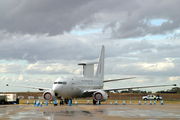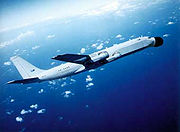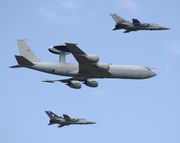Airborne early warning and control

.jpg)


An airborne early warning and control (AEW&C) system is an airborne radar system designed to detect aircraft. Used at a high altitude, the radars allow the operators to distinguish between friendly and hostile aircraft hundreds of miles away. AEW&C aircraft are used for defensive and offensive air operations. The system is used offensively to direct fighters to their target locations, and defensively to counter attacks. It can also be used to carry out surveillance, and C2BM (command and control, battle management) functions.
AEW&C is also known by the older terms "airborne early warning" (AEW) and "airborne warning and control system" (AWACS, pronounced /ˈeɪwæks/ AY-waks).
Contents |
General characteristics
Modern AEW&C systems can detect aircraft from up to 250 miles (402 km) away, well out of range of most surface-to-air missiles. One AWACS plane flying at 30,000 feet (9,100 m) can cover an area of 120,460 square miles (311,990 km2). Three such aircraft in overlapping orbits can cover the whole of Central Europe.[1] In air-to-air combat, AEW&C systems can communicate with friendly aircraft, extend their sensor range and give them added stealth, since they no longer need their own active radar to detect threats. However, by the nature of radar, AWACS aircraft can be detected by opposing forces beyond its own detection range. This is because the outgoing pulse reduces in strength the further it travels. Therefore, a signal which is intended to go out and be reflected back must be strong enough to cover at least twice the distance between the sender and the target; more in practice due to absorption losses.
History of development
As part of their early use of radar, the British developed a radar set that could be carried on an aircraft for "Air Controlled Interception". The intention was to cover the North West approaches where German long range Fw 200 Condor aircraft were a threat to shipping. A Vickers Wellington bomber (serial R1629) was fitted with a rotating antenna array. It was trialled for use against aerial targets and then for possible use against German E boats.[2][3] Another installation was a radar equipped Wellington used to direct Bristol Beaufighters onto Heinkel He 111s which were air-launching V-1 flying bombs.[4]
In February 1944 the U.S. Navy ordered the development of a radar system that could be carried aloft in an aircraft as Project Cadillac. A prototype system was built and flown in August on a modified TBM Avenger torpedo bomber. Tests proved successful, with the system being able to detect low flying formations at a range in excess of 100 miles (161 km). The U.S. Navy then ordered production of the TBM-3W, the first AEW aircraft to enter service. TBM-3Ws fitted with the AN/APS-20 radar entered service in March 1945, with some 36–40 eventually being constructed.
In 1958, the Soviet Tupolev Design Bureau was also ordered to design an AWACS aircraft. After trying to fit the projected radar instrumentation in a Tu-95 and a Tupolev Tu-116, the decision was made to use the Tu-114 fuselage instead. This solved the problems with cooling and operator space that existed with the narrower Tu-95 and Tu-116 fuselage. To meet the flight range requirements, the plane was fitted with an air-to-air refueling receiver. The resulting plane, the Tu-126, was used by the Soviet Air Forces until it was replaced by the Beriev A-50 in 1984.
National use
Many countries have their own AEW&C systems, although the E-3 Sentry and E-2 Hawkeye are the popular systems worldwide. The E-3 Sentry was built by the Boeing Defense and Space Group (now Integrated Defense Systems) and is widely considered to be an international benchmark for AEW systems. It is based on the Boeing 707 aircraft. The E-2 Hawkeye, which entered service in 1965, is arguably the most widely used AEW system. The E-3 Sentry is not strictly an AEW system, as it has far more functionality. For the Japan Air Self-Defense Force, the E-3 technology has been fitted into the Boeing E-767.
The United Kingdom first deployed a substantial AEW capability with American A-1 Skyraider which in turn were replaced by the Fairey Gannet AEW3, using the AN/APS-20 radar. When the Gannet was withdrawn, the Royal Air Force (RAF) deployed the radars taken from the Gannets on Avro Shackleton MR2 (maritime reconnaissance) airframes to make the Shackleton AEW2. This became the last piston-engined aircraft in the RAF. To replace this, they started to develop the Nimrod AEW.3, developed by de Havilland. However, the Nimrod AEW programme was cancelled just as the prototype completed its final trials in favor of procuring the E-3 from the U.S.
The Russian Air Force is currently using around 15–20 Beriev A-50 and A-50U "Shmel" in the AEW role. The "Mainstay" is based on the military/commercial Ilyushin Il-76 airframe, with a large non-rotating radome on the rear fuselage.
The Indian Air Force ordered three IAI Phalcon systems in 2004 of which the first arrived on May 25, 2009.[5] The Royal Australian Air Force and the Turkish Air Force are deploying Boeing 737 AEW&C aircraft. Unlike the E-2 and E-3, the Boeing 737 AEW&C does not have a radome. It will probably be marketed towards many existing E-2 customers, who would otherwise have no choice but to purchase a system intended for an aircraft carrier, due to lack of options.
The Swedish Air Force use the S 100B Argus as their AEW platform. The S 100B Argus is based on the Saab 340 with an Ericsson Erieye PS-890 radar.
The Hellenic Air Force, Brazilian Air Force and Mexican Air Force use the Embraer R-99 with an Ericsson Erieye PS-890 radar, as on the S 100B.
In early 2006, the Pakistan Air Force ordered six Saab 2000 fitted with Erieye AEW systems from Sweden in a deal valued roughly $1bn.[6] In December 2006, the Pakistan Navy requested three excess P-3 Orion aircraft equipped with Hawkeye 2000 AEW systems, the overall cost of the program is $855mn.[7] China and Pakistan also signed a memorandum of understanding (MoU) for the joint development of AEW&C systems. A total of $278m AWACS deal has been struck with China.[8]
There are only four helicopter-based AEW platforms in existence. One is the Royal Navy Sea King ASaC7 naval helicopter. It is operated from the Royal Navy's Invincible-class aircraft carriers. The creation of Sea King ASaC7, and earlier AEW.2 and AEW.5 is the consequence of the harsh lessons learnt by the Royal Navy task force sent to the South Atlantic in the 1982 Falklands War. The lack of AEW coverage for the task force was a major tactical shortcoming at the time. Also, the Spanish Navy fields the SH-3 Sea King in the very same role, operated from the carriers Principe de Asturias and Juan Carlos I
Another helicopter is the Russian-built Kamov Ka-31, deployed by Indian Navy on Krivak-III frigates and reportedly used by the Russian Navy on its sole Kuznetsov aircraft carrier. It is fitted with E-801M Oko (Eye) airborne electronic warfare radar which can track up to 20 targets simultaneously with aerial detection range 90 mi (150 km) and surface warships up to 160 mi (250 km).
The most modern helicopter-based AEW is the AgustaWestland EH101 AEW of the Italian Navy.
Some AEW systems feature additional command and control functionality, airborne warning and control system aircraft. These are often referred to as airborne early warning and control (AEW&C) systems.
AWACS systems

Boeing/Westinghouse AWACS system
This is a specific system with a rotating radar dome "rotodome" radome designed and built by Boeing (Defense & Space Group) using Westinghouse (now Northrop Grumman) radar. It is mounted on either the E-3 Sentry aircraft (Boeing 707) or more recently a modified Boeing 767. Only the Japanese Air Self-Defense Force has the 767 version, calling it the E-767.
Elta/Israeli Aircraft Industries (IAI) PHALCON radar
Israel has developed the IAI/Elta Phalcon system, which uses an AESA (Active Electronically Scanned Array) in lieu of a rotodome antenna. The system was the first such advanced radar placed into service. The original Phalcon was mounted on a Boeing 707 platform [9] and developed for the Israeli Defense Force and for export. A Boeing 707 Phalcon system was delivered to Chile in 1993 where it is known as the “Condor”.
The world's most advanced AEWC&C system, the PHALCON, was developed and produced by ELTA using Active Phased Array Electronic Scanning Technology rather than a mechanically rotating antenna (rotodome) used by current AWACS systems, giving PHALCON greater operational flexibility and performance by several orders of magnitude.
The Phalcon AEW&C aircraft is based on four sensors: phased-array radar, phased-array IFF, ESM/ELINT and CSM/COMINT. A unique fusion technology continuously cross-relates the data gathered by all sensors. When one of the sensors reports a detection, the system automatically initiates an active search of the complementary sensors.
The second generation improvement of the Phalcon system was accomplished in the development of the Israeli ground based IAI EL/M-2080 "Green Pine" radar target tracking system used by the Israeli Defense Force. This system has been exported to several countries.
Israel has recently put in service a third generation variant of the Phalcon system on a highly modified Gulfstream G550 [10] aircraft. Equipped with a more efficient and compact version of this airborne radar made by the ELTA division of Israel Aircraft Industries (IAI), the Gulfstream 550 CAEW is a long endurance, high altitude, rapid pop-up and descent system with unobstructed 360° coverage.
Israel Aircraft Industries (IAI) was marketing its Phalcon airborne early warning (AEW) system to China in competition with the British defense firm GEC-Marconi. In 1996 Tel Aviv and Beijing signed an agreement on purchasing the Falcon radar system, which China insisted system should be fitted onto Russian Il-76 aircraft. The Phalcon's triangular radar array would be mounted on the rear quarter fuselage of the Il-76 to provide full 360 degree scan coverage. Beijing was expected to acquire several PHALCON AEW systems, and reportedly could buy at least three more [and possibly up to eight] of these systems. But in July 2000 the United States pressured Israel to back out of a $1 billion agreement to sell China four Phalcon phased-array radar systems.
The India Air Force agreed in 2004 to purchase three systems for $1.1 billion. Russia and Israel on 10 October 2004 signed a tripartite agreement to facilitate the equipping of the Indian Air Force (IAF) with the Phalcon airborne warning and control systems. The IAF plans to mount the Phalcon radar and surveillance systems from IAI on IL-76 aircraft supplied by Russia.India received its first AWACS on 25th May 2009. It landed in Jamnagar AFB in Gujarat completing its 8 hour long journey from Israel.
List of AEW&C aircraft



- Brazil
- Embraer R-99A Erieye
- China
- KJ-1 AEWC
- KJ-200
- KJ-2000
- Y-8 AWACS/Y-8J AEW
- India
- Phalcon
- Kamov Ka-31 Helix
- DRDO AEW&CS
- Iran
- HESA IrAn-140
- Israel
- IAI 707 Phalcon
- IAI Eitam
- Italy
- Pakistan
- Saab 2000 Erieye
- ZDK-03Y-8 AWACS/Y-8J AEW
- Lockheed P-3 AEW&C
- Russia/Soviet Union
- Beriev A-50 Shmel
- Kamov Ka-31 Helix
- Tupolev Tu-126 Moss
- Saudi Arabia
- Sweden
- Saab 340 Erieye
- Saab 2000 Erieye
- United Kingdom
- E-3 Sentry
- Avro Shackleton
- Fairey Gannet
- Hawker Siddely Nimrod AEW3
- Seaking Mk 7 (AEW.5)
- United States
- Boeing 737 AEW&C
- E-3 Sentry
- Boeing E-767
- Boeing PB-1W Flying Fortress
- Douglas AD-3/4/5W Skyraider
- Grumman AF-2W Guardian
- Grumman E-1 Tracer
- Grumman E-2 Hawkeye
- Grumman TBM-3W Avenger
- Lockheed EC-121 Warning Star
- Lockheed EC-130V Hercules
- Lockheed P-3 AEW&C
- Turkey
- Boeing 737 AEW&C
See also
- Airborne Surveillance Platform
- Erieye radar
- JSTARS
- Phalcon
- US/Saudi AWACS Sale
References
- ↑ "AWACS: NATO’s eyes in the sky – How does it work in practice?". http://www.nato.int/issues/awacs/practice.html.
- ↑ Air-Britain, Aviation World, 2004
- ↑ Hodges, R "Air controlled interception" Radar Development to 1945 R W Burns (ed)
- ↑ Flypast April 1987: "The First AWACS"
- ↑ "Arms deal underway, first Israeli Phalcon lands in India – Israel News, Ynetnews". Ynetnews.com. June 20, 1995. http://www.ynetnews.com/articles/0,7340,L-3721499,00.html. Retrieved June 1, 2009.
- ↑ 07-Apr-2008 11:12 EDT (April 7, 2008). "Sweden Finalizes Saab 2000 AEW&C Contract With Pakistan". Defenseindustrydaily.com. http://www.defenseindustrydaily.com/sweden-finalizes-saab-2000-aewc-contract-with-pakistan-02377/. Retrieved June 1, 2009.
- ↑ "C4ISRJournal.com". C4ISRJournal.com. December 11, 2006. http://www.c4isrjournal.com/story.php?F=2416333. Retrieved June 1, 2009.
- ↑ "$278m AWACS deal struck with China: PAF » www.idrw.org / Indian Defense Research Wing". Idrw.org. http://www.idrw.org/2008/12/18/278m_awacs_deal_struck_with_china_paf.html. Retrieved June 1, 2009.
- ↑ B707 Phalcon, “Israeli Weapons.com”
- ↑ “Israel Now Flying New Phalcon AWACS”, “By Aero News 2/20/06 on OCNUS.NET”, “Oct 4, 2006”
